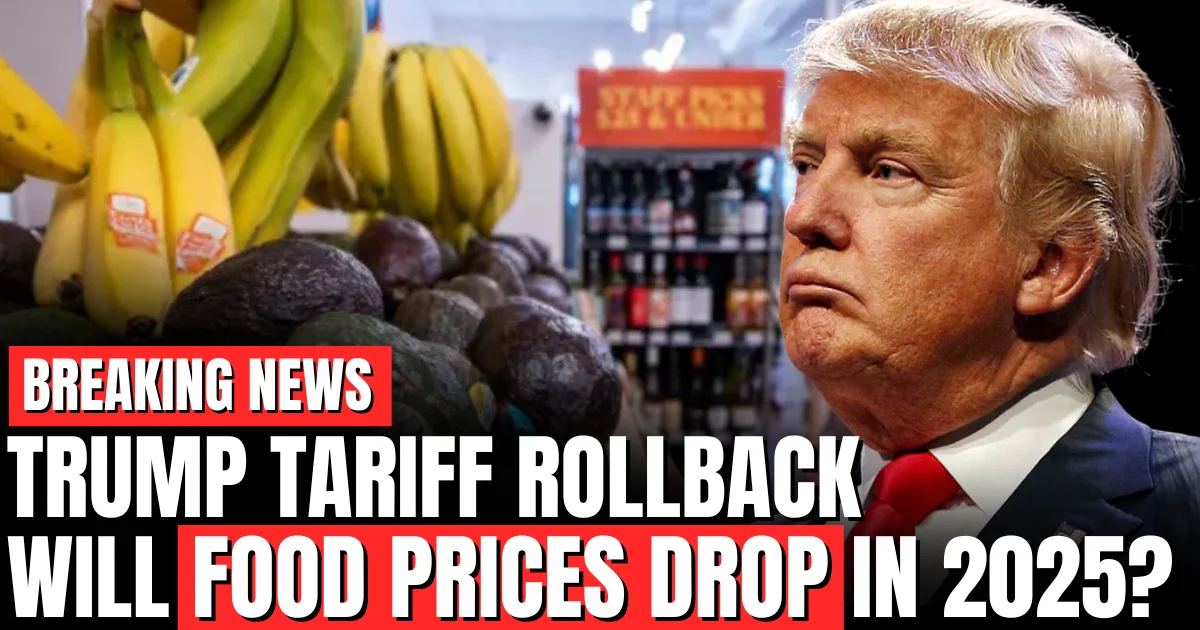Analysis of Trump’s tariff rollback plans and potential impact on grocery costs. Expert insights on whether American consumers will see lower food prices.
Table of Contents
Will Trump’s Tariff Rollback Actually Lower Your Grocery Bill? Economic Analysis
Former President Donald Trump’s proposals to roll back certain tariffs have sparked debate about whether American consumers will finally see relief at grocery store checkout lines. With food prices remaining stubbornly high, millions of households want to know if tariff changes could reduce their weekly shopping expenses.
Economic experts offer mixed predictions about how tariff adjustments might influence food costs. The relationship between trade policy and supermarket prices proves more complicated than simple cause-and-effect scenarios.
Understanding the Tariff-Food Price Connection
Tariffs function as taxes on imported goods, increasing costs for businesses that bring products into the United States. When companies pay higher import duties, they typically pass those expenses to consumers through increased retail prices.
Food products face varying tariff levels depending on category and country of origin. Some agricultural imports carry minimal duties while others encounter substantial barriers designed to protect American farmers.
How tariffs affect your grocery bill:
- Direct costs on imported food products and ingredients
- Indirect effects on domestic production expenses
- Supply chain disruptions from trade policy uncertainty
- Retaliatory tariffs affecting American agricultural exports
- Processing costs for manufacturers using imported ingredients
Many processed foods contain multiple imported components even when final assembly occurs domestically. Tariffs on ingredients like sugar, spices, oils, and specialty items accumulate throughout production chains before reaching consumers.
Which Food Categories Could See Price Changes
Certain grocery categories face more tariff exposure than others, making them prime candidates for price adjustments if trade policies shift.
High-impact food categories:
Fresh Produce
America imports substantial quantities of fruits and vegetables, especially during winter months when domestic growing seasons end. Mexican and Central American produce supplies significant portions of supermarket selections. Tariff changes on these imports could directly impact prices.
Seafood Products
The United States imports approximately 80-90% of consumed seafood from countries including China, Vietnam, Thailand, and Canada. Seafood tariffs significantly affect consumer costs, making this category particularly sensitive to trade policy changes.
Coffee and Cocoa
These commodities come entirely from foreign sources since climate prevents domestic production. Any tariff adjustments on coffee and chocolate products would directly translate to consumer price changes.
Processed Foods
Many packaged goods contain imported ingredients including sweeteners, oils, flavorings, and preservatives. Cumulative tariff effects on multiple components influence final retail prices substantially.
Alcoholic Beverages
Wine, beer, and spirits from Europe and other regions face various tariff levels. Trade policy changes could significantly affect prices in this discretionary category.
Expert Economic Predictions
Economists debate the magnitude and timeline of potential food price changes resulting from tariff adjustments. Professional forecasters consider multiple variables beyond simple tariff elimination.
Optimistic scenario supporters argue:
Removing tariffs on key food imports would reduce business costs that companies could pass to consumers as savings. Competition among retailers might accelerate price reductions as stores seek market share advantages.
Agricultural economists note that even modest percentage decreases across multiple categories could save average families hundreds annually. For budget-conscious households, these savings provide meaningful financial relief.
Skeptical analysts counter:
Companies rarely reduce prices as quickly as they raise them. Businesses might pocket tariff savings as improved profit margins rather than passing benefits to customers.
Food prices reflect numerous factors beyond import duties including labor costs, transportation expenses, packaging materials, and domestic agricultural conditions. Tariff changes address only one component of complex pricing structures.
Key economic considerations:
- Lag time between policy changes and retail price adjustments
- Company decisions about absorbing vs. passing cost changes
- Competitive dynamics in concentrated food industry
- Inflation momentum and wage pressure effects
- Supply chain efficiency and transportation costs
Most economists agree that tariff rollbacks alone cannot solve food inflation comprehensively. However, targeted reductions could provide modest relief in specific categories.
Agricultural Sector Implications
American farmers and ranchers watch tariff discussions closely since trade policy directly affects their economic viability. Competing interests create complex political dynamics.
Domestic agriculture concerns:
Farmers who compete with imported products generally support protective tariffs maintaining price levels for their crops. Removing these trade barriers could reduce domestic agricultural income.
Conversely, export-oriented farmers suffer when trading partners retaliate against American tariffs. Soybean, corn, pork, and wheat producers particularly depend on foreign market access.
Agricultural industry positions:
Dairy producers express concern about increased competition from Canadian and European imports if tariffs decrease. The industry argues that protection supports rural economies and food security.
Fruit and vegetable growers in states like California and Florida compete directly with Mexican imports. These producers typically oppose tariff reductions on competing products.
Livestock operations face mixed effects since feed costs might decrease while meat import competition could intensify. Net impacts vary by specific operation type and market positioning.
Historical Precedents and Lessons
Previous tariff adjustments provide insights into likely outcomes from policy changes. Economic history offers relevant examples of trade policy impacts on consumer prices.
The 2018-2019 tariff escalations increased costs for numerous food products and ingredients. Studies documented price increases for items including coffee, chocolate, cheese, and various processed goods.
When some tariffs were subsequently reduced or eliminated, price responses varied significantly across categories. Competitive products saw faster adjustments while items from concentrated industries changed more slowly.
Lessons from recent tariff history:
- Price increases from new tariffs occur faster than decreases from removals
- Industry concentration affects how companies respond to cost changes
- Consumer awareness influences retailer pricing decisions
- International supply chain complexity delays adjustment processes
- Political considerations often outweigh pure economic optimization
These historical patterns suggest that tariff rollback benefits might materialize slowly and unevenly across grocery categories.
Timeline Expectations for Consumers
Even if tariff changes occur quickly at policy levels, consumer price impacts follow delayed timelines. Multiple steps separate trade policy decisions from supermarket shelf prices.
Expected timeline stages:
Immediate (0-3 months)
Policy announcements and initial regulatory changes. Little consumer price impact during this phase as existing inventory moves through retail channels.
Short-term (3-6 months)
Importers begin benefiting from reduced tariffs on new shipments. Some cost savings might reach wholesale buyers but retail prices change minimally.
Medium-term (6-12 months)
Competitive pressures and inventory turnover gradually enable retail price adjustments. Consumers might notice modest decreases in heavily imported categories.
Long-term (12+ months)
Full market adjustment reflects new tariff environment. Supply chains optimize for changed incentive structures. Maximum consumer benefits materialize if they occur at all.
This extended timeline means that even beneficial tariff changes provide no immediate grocery bill relief for struggling families.
Political Realities and Implementation Challenges
Tariff policy decisions involve complex political negotiations balancing competing interests. Implementation faces numerous practical obstacles beyond presidential preferences.
Political complicating factors:
Congressional approval may be required for certain tariff changes depending on their legal origins. Legislative processes introduce delays and potential modifications.
Industry lobbying efforts intensify when specific sectors face tariff adjustments affecting their competitive positions. Well-organized agricultural and food industry groups wield substantial political influence.
Trading partner cooperation is essential for comprehensive tariff restructuring. Negotiations take time and involve reciprocal concessions beyond simple unilateral American changes.
Implementation obstacles:
Regulatory procedures require formal review periods and public comment opportunities. These administrative requirements extend timelines significantly.
Verification systems must ensure proper tariff classifications and prevent fraud. Customs enforcement capabilities affect how quickly new policies become operational.
International trade agreement modifications involve lengthy diplomatic processes. Many tariffs exist within broader treaty frameworks requiring coordinated changes.
What Consumers Can Expect Realistically
Setting appropriate expectations helps consumers plan household budgets without counting on uncertain savings.
Realistic predictions:
Modest price decreases might occur in heavily tariffed categories like seafood and certain specialty imports. Savings would likely measure in single-digit percentages rather than dramatic reductions.
Most staple groceries would see minimal direct impacts since domestic production dominates categories like dairy, meat, eggs, and many vegetables. Tariff changes affect these items peripherally through input costs.
Overall grocery inflation trajectories depend more on labor markets, energy prices, and agricultural conditions than tariff policies alone. Trade adjustments represent one factor among many.
Consumer action recommendations:
Continue budgeting based on current price levels rather than anticipated decreases. Pleasant surprises beat financial shortfalls from unrealized savings.
Focus on controllable cost reduction strategies including seasonal shopping, store brands, bulk purchasing, and meal planning. These approaches deliver reliable savings unlike uncertain policy changes.
Monitor specific categories with high import content for potential price improvements. Seafood, coffee, chocolate, and tropical fruits offer better possibilities than domestic staples.
Broader Economic Context
Food price discussions occur within larger economic circumstances affecting household finances comprehensively.
Wage growth, employment levels, and overall inflation rates influence grocery affordability as much as absolute prices. Families with rising incomes find food costs less burdensome even if prices remain elevated.
Interest rates affect financing costs for homes and vehicles, influencing how much households have available for groceries. Comprehensive economic policies matter more than isolated tariff adjustments.
Energy prices particularly impact food costs through transportation and processing expenses. Fuel cost changes often affect grocery bills more directly than tariff modifications.
FAQ SECTION
1. How quickly would tariff rollbacks reduce grocery prices?
Economic experts predict that even if tariff eliminations happen quickly at policy levels, consumer price impacts would take 6-12 months to materialize significantly. Importers must first benefit from reduced duties on new shipments, then wholesale buyers see savings, and finally retail competition might drive price decreases. Existing inventory moves through supply chains at current prices, delaying consumer benefits substantially.
2. Which grocery items would see the biggest price drops from tariff changes?
Products with high import content and direct tariff exposure offer the greatest potential for price decreases. Seafood represents the strongest candidate since America imports 80-90% of consumption. Coffee, chocolate, tropical fruits, and certain specialty items also face significant tariffs. Conversely, domestic staples like dairy, most meats, and many vegetables would see minimal direct impacts.
3. Do companies actually lower prices when their costs decrease?
Economic research shows that businesses reduce prices more slowly than they raise them when costs change. Companies might retain tariff savings as improved profit margins rather than passing benefits to customers, especially in concentrated industries with limited competition. However, competitive pressure in retail grocery markets could force some price reductions, particularly for commodity products with transparent pricing.
4. How much could average families save from tariff rollbacks?
Savings estimates vary widely depending on which tariffs change and household purchasing patterns. Optimistic projections suggest families might save $200-400 annually if comprehensive tariff reductions occur and companies pass savings to consumers. However, skeptical economists note that tariffs represent only one factor among many affecting food prices, making dramatic savings unlikely for most households.
5. Could tariff rollbacks hurt American farmers?
Yes, some domestic agricultural producers could face increased competition from imports if protective tariffs decrease. Dairy farmers, fruit growers, and vegetable producers who compete directly with foreign suppliers particularly worry about market share losses. However, export-oriented farmers might benefit if trading partners reciprocate by reducing their tariffs on American agricultural products.
CONCLUSION
Trump’s proposed tariff rollbacks could provide modest relief on specific grocery categories, but expecting dramatic across-the-board price decreases sets unrealistic expectations. The relationship between trade policy and supermarket prices involves complex factors extending beyond simple tariff elimination.
Consumers struggling with food costs should continue employing proven savings strategies rather than waiting for uncertain policy benefits. Smart shopping habits, seasonal purchasing, and meal planning deliver reliable results unlike speculative price changes from future tariff adjustments.
Understanding that food inflation reflects labor costs, energy prices, agricultural conditions, and numerous other factors helps maintain realistic perspectives. Tariff policy represents one piece of a much larger economic puzzle affecting household grocery budgets.
Do you believe tariff changes will meaningfully reduce your grocery expenses? What strategies have you found most effective for managing food costs? Share your experiences and perspectives in the comments below!

